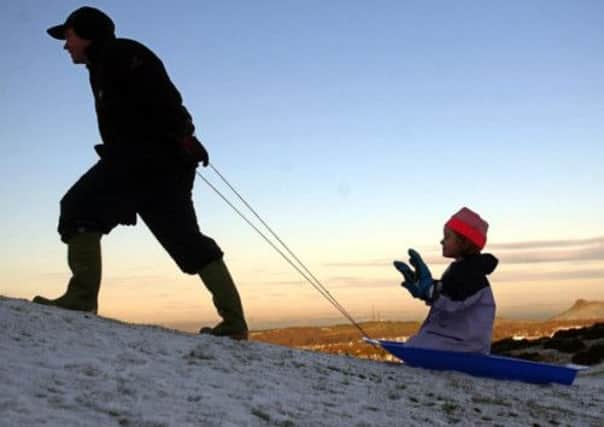Winter sports: A guide to sledging in Scotland


It is that time of year when organised parents will be waxing the toboggan runners, checking child-sized ski suits still fit and making sure every waterproof glove has a pair. For the rest of us, the first decent fall of snow might see children requisitioning tin trays and bin bags, but a bit of preparation pays off, particularly if this year sees every child’s dream come true, and an overnight snowfall gives them an unexpected day off school to go sledging.
Neil White, who owns sledges.co.uk, says some customers take their sledging very seriously indeed. “We get the first raft of orders in about October, as soon as the weatherman forecasts the first cold north wind.” These are the sensible people, but there are last-minute buyers too. “We get another raft of orders when the snow is imminent, but some types of sledge will be sold out by then and even though we do next-day delivery, snow in the UK tends not to last very long and of course wintry weather can disrupt the post so you are best to think ahead if you don’t want your sledge to arrive the day after the big melt.”
Advertisement
Hide AdThe company sells a range of sledges from inexpensive plastic models to more high-tech racing toboggan types, and the traditional slatted wooden sledges. The latter are crafted from beech wood in Scandinavia and Germany and are at the top end of the price range – about £85 for the classic Lillehammer Rodel. For those who are really serious about speed and technique there are aluminium designer models and even a Snow Bike, with a seat, three ski runners for balance and handlebars at £90.
The perfect choice of sledge is not just about budget, but like the famous delayed train excuse, depends on the type of snow. White actually recommends the less expensive plastic models, ranging in price from under £10 for a flying saucer model with two handles at the side to more sophisticated sledges with brakes and even a steering wheel. “The wooden ones really need deep snow conditions so if you are planning on taking one to a ski resort to sledge then it is worth investing in. For the normal type of UK snow, ie not very thick, you are better off with plastic or aluminium, which skim across the surface.”
It also depends on the age of the children; teenagers keen to produce the greatest speed and the most spectacular wipeouts may prefer to descend head first on a sledge and control it by moving their weight, while parents with little children will be looking for a model that can take an adult and a child, and has good safety features. Inflatables are great for very small children and they come in the shape of penguins and polar bears. For older children, however, these can be a disappointment. My two teens tried them last year and were left “ooshing” themselves down the slope at a snail’s pace – this year they have been given away to smaller, lighter children who don’t seem to have the same problem.
For new parents there is the alarming-sounding Baby Luge, which is thankfully not so much for whizzing your precious bundle downhill, Cresta Run-style, but for mothers and fathers to harness in a tot and pull behind them, in padded comfort. It is perfect for walks in the snow and gives a first taste of winter sports to the under-twos.
As for where to go, rural areas are spoilt for choice, as long as you pick a slope without steep drop-offs, rocks or gorse bushes. Cities can also provide some great runs, particularly in parks, well away from traffic. In Edinburgh, top sledgers rate the Meadows for gentle slopes, the Braids for long runs and Holyrood Park for the serious stuff, while in Glasgow, there is Kelvingrove Park or to the north at Strathblane, Mugdock Country Park provides a good range of gentle and more challenging sledging spots. My own favourite location in the central belt is King’s Knot, in Stirling. The ornamental raised circles and mounds were originally laid out in the Middle Ages for Scottish monarchs to provide a symmetrical view from the castle above. I don’t know if the royals ever scared themselves witless by whizzing down the narrow and steep slopes on an upturned shield in the snow, but if they didn’t they were missing a trick.
As well as the unofficial sites, Scotland has five winter sports resorts where sledging plays a big part. Aviemore & Glenmore Snowsports Hire and School have a site between Aviemore and Cairngorm mountain base, by the Glenmore estates, which in summer is a gently sloping hay field. Come the first snow, however, it is turned into a brilliant sledging site well away from skiers and snowboarders and open to any age. Sledge hire is available for £6, so even if you live in the few areas of Scotland which won’t get white stuff this year, a day in the snow is still possible.
Aviemore & Glenmore Snowsports Hire and School, tel: 01479 861253.